Prosthetic dentistry is a field of dentistry, which focuses on diagnosis and treatment of dysfunction of dentition by using dental prosthesis or regulatory devices.
Prosthetic dentistry in Yerevan, Armenia
Today, dental prosthesis include: microprosthesis, removable prosthesis and fixed prosthesis, prosthesis on dental implants, clasp prosthetics, bridge prosthetics, as well as conditionally removable prosthetsis.
Crowns
Crowns are prosthetic constructions that completely cover the damaged tooth, and also allow you to change the shape of the tooth and its appearance.
Today, dental crowns are made of metal alloys, cermets, porcelain, and zirconia.
In the GDC clinic, dental crowns are modeled and manufactured in own dental laboratory, which is equipped with CAD / CAM equipment of the German company Amann Girrbach.
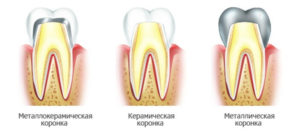
Metal Crowns
Metal crowns are an old kind of crowns. Their main advantages are strength and affordable cost, and the main minus is a low aesthetic results.
Metal ceramic crowns
The inner, invisible part of the crown is cast from metal, and the outer, made of ceramics. The advantages of such crowns are a combination of strength and aesthetics, and a disadvantage is the possible translucence of the metal part.
Zirconia
Zirconia tooth crowns have high strength, long service life, high aesthetic performance and biocompatibility. The disadvantage of such crowns can be called a relatively high cost, but in the long run such a price is fully justified.
Ceramic Crowns
Ceramic crowns give the highest aesthetic results; they are biocompatible and give the possibility to create constructions, which are indistinguishable in color and transparency from natural teeth. Such crowns are ideal for installation in the smile zone, but because of insufficient strength, they are not always suitable for prosthetics in the chewing part.
Veneers
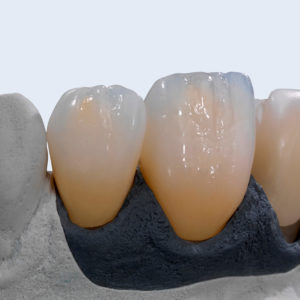 Veneers are very thin dental layers made of porcelain or composites. They are placed to the external surface of the tooth.
Veneers are very thin dental layers made of porcelain or composites. They are placed to the external surface of the tooth.
Composite veneers can be placed in two ways, using a laboratory method (indirect method), or directly layering the veneer in the oral cavity of the patient (direct method).
The direct method is used when it is necessary to restore one or two teeth, the veneers will be placed during one visit and serve up to five years. The laboratory method allows achieving an improved effect and a longer service life of composite restorations.
Unlike composite, ceramic can be fabricated only in the laboratory. After the preparation of the teeth, the dentist makes an impression and then the technician will make the permanent veneer.
Ceramic veneers allow a qualitative restoration of a large number of teeth, they are more durable and do not change the color shades during long-term operation.
The use of veneers has several advantages:
- An absolutely natural smile;
- Even with regular coffee drinking and smoking, there are no stains on the surface of the veneers, changes in color shades or discoloration;
- They prevent the formation of plaque and stone.
Lumineers
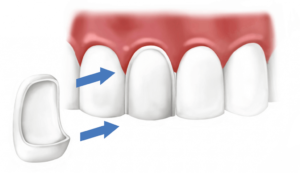 Lumineers are ultra-thin (0.2-0.3 mm thick) layers made of highly strength ceramics. Due to its super thinness, lumineers allow not to grind the restored teeth.
Lumineers are ultra-thin (0.2-0.3 mm thick) layers made of highly strength ceramics. Due to its super thinness, lumineers allow not to grind the restored teeth.
Despite its relatively high cost, lumineers are very popular today, because they have the highest aesthetic performance.
Dental Bridges
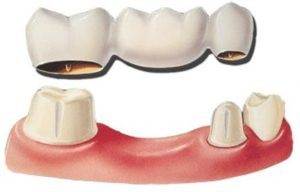 A bridge is a fixed dental restoration (a fixed dental prosthesis) used to replace one or more missing tooth by joining an artificial tooth definitively to adjacent teeth or dental implants.
A bridge is a fixed dental restoration (a fixed dental prosthesis) used to replace one or more missing tooth by joining an artificial tooth definitively to adjacent teeth or dental implants.
Removable and partially removable dentures
The need for fully removable or partially removable dentures arises in cases where the problem can not be solved with non-removable prosthesis.
Partially removable dentures are attached to the gums and to natural teeth. They include:
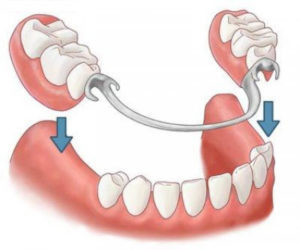 Acrylic dentures – are made of acrylic plastic and fastened with special hooks.
Acrylic dentures – are made of acrylic plastic and fastened with special hooks.
Non-acrylic dentures are made of acrylic resins that do not contain substances that can cause irritation of the gums. These prostheses are characterized by high strength and dense fit to the gum.
Traditional nylon dentures are effective in restoring small segments of the dentition.
Clasp denture is a cast metal frame, which is covered with an acrylic layer. On the frame are installed artificial teeth. The metal structure allows you to evenly distribute the load when chewing. In comparison with the above constructions, the clasp prosthesis takes up less space in the oral cavity. Such a prosthesis can be fixed by hooks, micro-locks, telescopic crowns.
Complete removable dentures
Complete removable dentures are used in the complete absence of teeth (full adentia). Modern technology allows choosing individually the shape and color.
